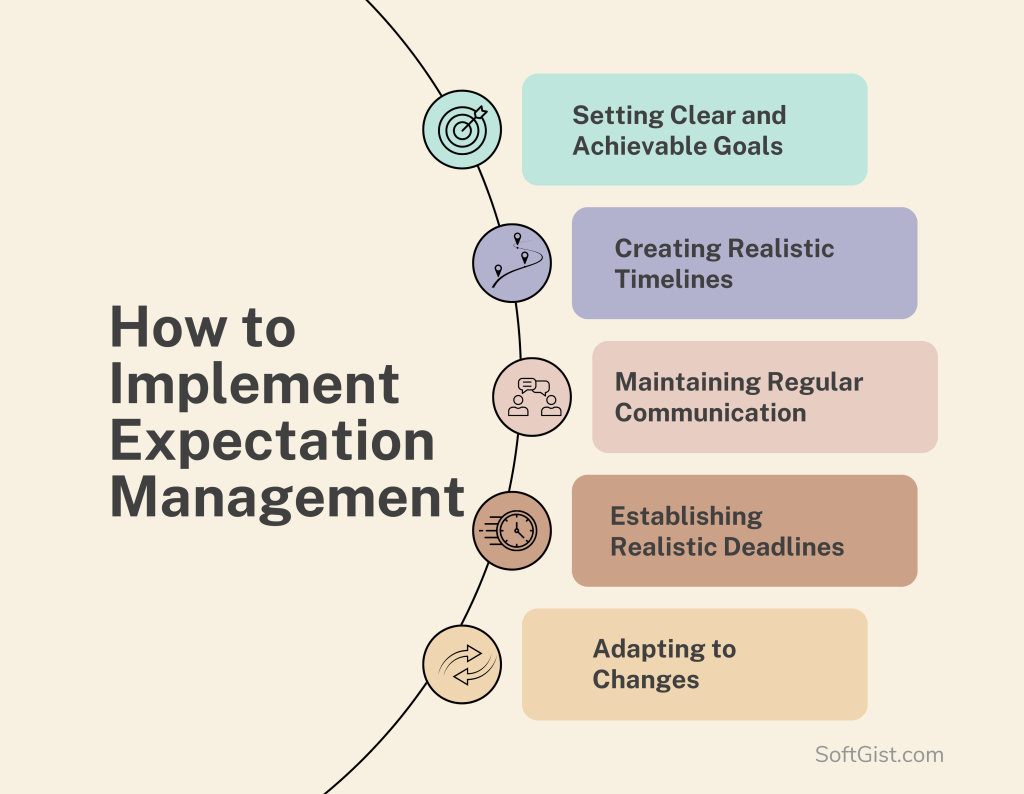Managing Expectations: A How-to Guide
Updated May 27, 2024
Published November 12, 2023

Managing expectations is a key part of our daily lives, though we might not always notice it. It’s all about understanding and handling what’s expected in different situations.
In the workplace or at home, managing expectations helps things go smoothly. But what does it really involve?
We’ll explore this topic, showing its importance in various settings. You’ll see how it affects both work and personal life. Let’s get into the details of setting and managing expectations.
What is Expectation Management?
Expectation management is a key strategy in both personal and professional settings. It involves setting, communicating, and maintaining clear expectations. This process helps prevent misunderstandings and disappointment. There are several approaches to expectation management:
- Top-Down Approach: In this method, leaders set the overall goals and expectations. These are then communicated to the team, providing clear direction and objectives.
- Bottom-Up Approach: Here, the process starts with the team members. They identify goals and communicate these upwards. This approach values the input from those doing the work, making it responsive and adaptable.
- Participative Management: This is a combination of both top-down and bottom-up methods. It aims to leverage the clarity from leaders and the insights from team members, fostering a collaborative environment.
Understanding and applying these approaches can lead to more effective management of expectations, ensuring everyone involved has a clear understanding of goals and responsibilities.
Benefits of Expectation Management
Managing expectations effectively brings many benefits, both in work and personal life. Here’s why it’s so important:

- Reduces Stress: When everyone knows what to expect, there’s less worry and uncertainty. This can make work environments and personal interactions more relaxed and enjoyable.
- Clear Goals and Objectives: Having well-defined expectations helps everyone understand their roles and responsibilities. This clarity ensures that efforts are focused and aligned with the desired outcomes.
- Improved Communication: Clear expectations open up lines of communication. People feel more comfortable discussing progress and any issues that might arise. A study by Spike Cavell reveals that poor communication is the root cause of 57% of project failures. When teams fail to communicate effectively, it often leads to a decrease in transparency.
- Stronger Cooperation: When expectations are managed well, it fosters a sense of teamwork. People are more likely to work together effectively if they have a shared understanding of goals.
- Increases Chances of Success: Projects or personal plans are more likely to succeed when expectations are clear from the start. This is because everyone involved is working towards the same goals and understands how to achieve them.
- Enhances Relationships: In personal relationships, managing expectations can lead to better understanding and fewer disappointments. It helps in setting boundaries and respecting each other’s needs.
In essence, expectation management is about creating a roadmap for success, where everyone knows the destination and the path to get there. It’s a skill that, when used effectively, can lead to more productive, satisfying, and successful outcomes in all areas of life.
Common Challenges in Expectation Management

Managing expectations isn’t always easy. Here are some common challenges:
- Miscommunication: Sometimes, what we think we’ve communicated clearly isn’t understood the way we intended. This can lead to mismatched expectations.
- Changing Expectations: People’s expectations can change over time. Keeping up with these changes and adapting can be tricky.
- Balancing Different Expectations: In a team or a relationship, different people might have different expectations. Finding a balance that satisfies everyone can be difficult.
- Unrealistic Expectations: Sometimes, expectations set by others, or even ourselves, can be too high or unrealistic. Managing these and bringing them to a realistic level is crucial.
- Consistency in Follow-Up: Setting expectations is one thing, but consistently following up to ensure they are met is another. This requires ongoing effort and attention.
Each of these challenges requires careful navigation. Good expectation management involves recognizing these challenges and developing strategies to address them effectively.
How to Implement Expectation Management

Implementing expectation management effectively involves several key steps:
Setting Clear and Achievable Goals
The first step is to define goals that are both clear and achievable. This involves understanding the capabilities and limits of your team or project. Clear goals provide a roadmap for what needs to be accomplished, making it easier for everyone to stay on track.
Creating Realistic Timelines
It’s important to set timelines that are realistic. Overly ambitious deadlines can lead to stress and rushed work, which often results in subpar outcomes. Realistic timelines allow for quality work and help manage expectations around project completion dates.
Maintaining Regular Communication
Frequent and open communication is vital in expectation management. Keeping everyone informed about progress, changes, and any potential roadblocks helps in maintaining transparency and trust. This also provides an opportunity for feedback, which can be crucial for adjusting expectations and strategies.
Establishing Realistic Deadlines
Deadlines should be set with a clear understanding of the task’s complexity and the team’s capacity. Unrealistic deadlines can lead to disappointment and a feeling of failure, even if significant progress has been made.
Adapting to Changes
Flexibility is key in expectation management. The ability to adapt to changing circumstances or new information can mean the difference between success and failure. Being open to revising goals, timelines, and strategies as needed is crucial for effective expectation management.
Finding the Right Balance
Managing expectations effectively also means not going overboard. It’s about finding a balance where you give enough information to set clear expectations, but also leave room for flexibility and creativity.
Avoiding Over-Management
In managing expectations, it’s crucial not to overdo it. Over-managing can lead to micro-managing, which often stifles creativity and motivation. The goal is to guide processes and people without dominating every aspect. It’s about trusting others to meet their responsibilities while providing necessary support.
Encouraging Individual Interpretation
Each person brings unique experiences and viewpoints. Allowing room for individual interpretation fosters creativity and can lead to innovative solutions. It’s important to recognize and value these different perspectives, as they can significantly contribute to the success of any project or relationship.
Preparing for Variability
Understanding that situations and people are dynamic is key to managing expectations effectively. Being too rigid can cause frustration when changes arise. Expectation management should be flexible enough to adapt to new circumstances, recognizing that plans may need to evolve.
Case Study: Expectation Management in Project Management
In the realm of project management, expectation management is a pivotal aspect for achieving success and aligning with stakeholders’ goals. A compelling example of this is the Henry Mayo Newhall Hospital’s approach to enhancing its Outpatient Surgical Center performance.
The hospital’s Performance Excellence Office adeptly combined methodologies like PMBOK, Lean, Scrum, and Waterfall. This approach was instrumental in involving stakeholders, exploring various solutions, and maintaining clear communication.
From this case study, we can draw several key tips for managing expectations effectively in project management:
- Set Realistic Expectations: Offering a practical timeline to clients helps set a feasible scope for the project.
- Transparent Communication: Clear and honest dialogue is essential to keep everyone informed and aligned.
- Stakeholder Involvement: Involving stakeholders from the start ensures their needs and expectations are considered in the planning phase.
- Defined Roles and Responsibilities: Clarifying each team member’s role prevents confusion and overlaps, streamlining the project process.
- Regular Progress Monitoring: Keeping a tab on the team’s progress and providing feedback helps in making necessary adjustments timely.
- Frequent Meetings: Conducting regular meetings with the team and stakeholders helps in revisiting and reinforcing the project expectations.
By implementing these strategies, project managers can navigate the complexities of managing expectations, leading to successful project outcomes and stakeholder satisfaction. This case not only demonstrates the effectiveness of these strategies but also serves as a guide for applying them in various project scenarios.
Conclusion
Wrapping up, expectation management is all about clarity and flexibility. It’s making sure everyone understands what’s expected.
Being clear about goals is important. But it’s also key to stay flexible when things change.
The goal is to guide, not to control every detail. This approach can improve teamwork and make projects run smoother.
It’s a valuable skill in both work and personal life. It helps in handling various situations effectively.
Share This Post
Della Yang
Della Yang is a marketing professional with a passion for the ever-changing digital landscape. She frequently writes tech news and reviews, sharing her knowledge and insights through blogs and various online platforms.
Allow cookies
This website uses cookies to enhance the user experience and for essential analytics purposes. By continuing to use the site, you agree to our use of cookies.
